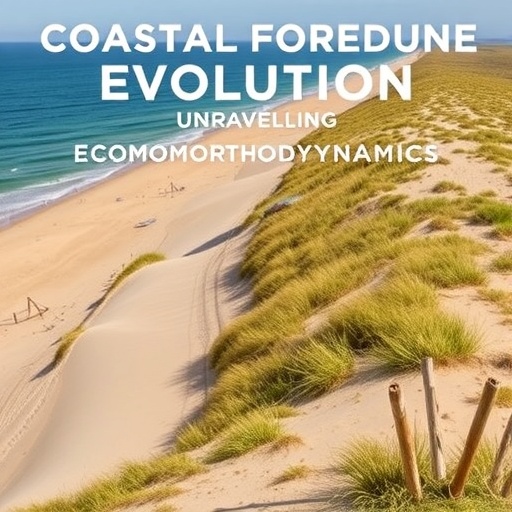Coastal environments are undergoing significant transformations as climate change and anthropogenic influences alter their dynamics. Among the most critical components of coastal ecosystems are foredunes—precarious structures that often serve as the first line of defense against oceanic forces. Foredunes are primarily formed by the interaction of sand transport mechanisms and vegetative processes, collectively termed ecomorphodynamics. These interactions not only foster dune stability but also contribute to habitat functionality and shoreline protection. Recent analyses provide vital insights into how these systems evolve and respond to varying environmental pressures.
Foredunes play a crucial role in safeguarding coastal communities by buffering them from wave action and storm surges, thereby highlighting their significance in the realm of ecosystem services. The evolution of these structures is determined by a variety of factors, including the supply of sand, the density and type of vegetation, and overarching climatic conditions. For instance, studies reveal that the characteristics of vegetation significantly dictate foredune morphology. Low-lying, creeping herbaceous plants typically prompt the formation of short, embryonic dunes, while more robust, upright grasses tend to foster the emergence of tall, narrow foredunes, thus manifesting the critical relationship between flora and geomorphology.
Sand supply is a vital component in the construction of foredunes. Variability in the availability of sand due to fluctuations in coastal processes can either facilitate or hinder dune growth. Additionally, vegetation density plays a significant role in determining how effectively sand is trapped and accumulated. Dense grass species can create a windbreak, allowing sand to settle and build the dune, whereas sparse vegetation may result in increased erosion and destabilization of these natural barriers.
The effects of anthropogenic activities on foredunes cannot be understated. Actions like beach nourishment—where sand is artificially added to shorelines—have been shown to enhance the supply of sand to foredunes. This, in turn, aids in the rebuilding processes of these critical structures. However, the presence of human infrastructure along coastlines can complicate these dynamics, often restraining natural foredune development and leading to enhanced vulnerability to erosion and storm damage.
Natural disturbances, particularly extreme weather events such as hurricanes and tropical storms, have catastrophic impacts on foredune formations. The aggressive erosion caused by such events can dramatically reshape dune landscapes and disrupt the delicate balance of ecomorphodynamic processes. These events have the potential to reset the evolutionary track of foredunes, leading to periods of significant recovery or further erosion depending on subsequent environmental conditions.
Another pressing concern affecting coastal ecosystems is the phenomenon of sea-level rise, which is exacerbated by climate change. Rising seas not only increase the frequency and intensity of coastal flooding but also induce saltwater intrusion into freshwater systems, further complicating vegetation dynamics on foredunes. These changes raise urgent questions about the future stability of these critical natural barriers and the broader implications for coastal communities.
Even small-scale disturbances, such as herbivory from local wildlife or pedestrian trampling, can lead to significant erosion and loss of vegetation cover in dune systems. This localized impact can diminish the structural integrity of foredunes, leading to more extensive erosion and harming the overall biodiversity that these habitats support. The resilience of foredunes is therefore constantly tested by both natural and anthropogenic forces.
Management strategies focusing on the preservation and restoration of foredunes must take into consideration the multifaceted interactions between vegetation, sand supply, and external disturbances. Future research must prioritize a holistic understanding of ecomorphodynamics in the context of climate variability, ensuring that strategies remain adaptive and effective in the face of rapidly changing conditions.
Simultaneously, comprehensive modeling and empirical studies are essential to uncovering the nuances of how these coastal systems respond to alterations in climate and human activities. By integrating observations from diverse regions and contexts, this research can fill significant knowledge gaps, ultimately informing effective management and restoration strategies.
The ongoing evolution of foredunes reflects broader trends in coastal resilience and adaptation. As environmental pressures continue to mount, facilitating healthy foredune systems can play a pivotal role in protecting coastal ecosystems and communities. Understanding the complex interplay between vegetation and geomorphology will be crucial in navigating the future of coastal dynamics in a changing world.
In conclusion, the intricate interdependencies between sand transport, vegetation, and anthropogenic influences underscore the ecological significance of foredunes. As coastal environments are increasingly challenged by climate change and human activities, prioritizing research and management efforts that focus on the resilience of these key systems is essential. The future health of coastal communities may very well hinge on our ability to maintain and enhance the functions of foredunes as natural barriers against the evolving threats of a dynamic coastal landscape.
Subject of Research: Ecomorphodynamics of Coastal Foredune Evolution
Article Title: Ecomorphodynamics of coastal foredune evolution
Article References:
Moore, L.J., Hacker, S.D., Breithaupt, J. et al. Ecomorphodynamics of coastal foredune evolution.
Nat Rev Earth Environ 6, 417–432 (2025). https://doi.org/10.1038/s43017-025-00672-z
Image Credits: AI Generated
DOI: 10.1038/s43017-025-00672-z
Keywords: coastal ecosystems, foredunes, ecomorphodynamics, vegetation dynamics, climate change, sand transport, storm erosion, habitat protection, coastal management, biodiversity.




